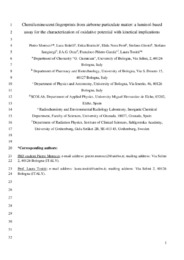Please use this identifier to cite or link to this item:
https://hdl.handle.net/11000/35192Full metadata record
| DC Field | Value | Language |
|---|---|---|
| dc.contributor.author | Morozzi, Pietro | - |
| dc.contributor.author | Bolelli, Luca | - |
| dc.contributor.author | Brattich, Erika | - |
| dc.contributor.author | Ferri, Elida Nora | - |
| dc.contributor.author | GIROTTI, STEFANO | - |
| dc.contributor.author | Sangiorgi, Stefano | - |
| dc.contributor.author | Garcia Orza, Jose Antonio | - |
| dc.contributor.author | Piñero-García, Francisco | - |
| dc.contributor.author | Tositti, Laura | - |
| dc.contributor.other | Departamentos de la UMH::Física Aplicada | es_ES |
| dc.date.accessioned | 2025-01-23T20:17:51Z | - |
| dc.date.available | 2025-01-23T20:17:51Z | - |
| dc.date.created | 2021 | - |
| dc.identifier.citation | Science of The Total Environment | es_ES |
| dc.identifier.issn | 1879-1026 | - |
| dc.identifier.issn | 0048-9697 | - |
| dc.identifier.uri | https://hdl.handle.net/11000/35192 | - |
| dc.description.abstract | In this study, a new chemiluminescent method based on the dependence of luminol light emission induced by free radicals in airborne particulate matter (PM) is proposed as a screening assay for the rapid characterization of samples from different sources based on their redox properties. This parameter is considered critical for assessing particulate matter toxicity and its impacts on human health. We propose a cell-free, luminescent assay to evaluate the redox potential of particulate matter directly on the filters employed to collect it. A joint chemometric approach based on Principal Component Analysis and Hotelling Analysis was applied to quickly sort out ambient particulate samples with a significantly different light emission profile caused by Luminol reaction. Based on Spearman correlation analysis, the association of the samples light emission intensity with their chemical composition and emission sources was attempted. The overall methodology was tested with certified reference materials and applied to two series of particulate matter samples previously subjected to thorough chemical speciation and subsequent source apportionment. The results show the effectiveness of the luminescent method, allowing the quick assessment of particulate matter oxidative potential, but providing further evidence on the complexity of the oxidative potential determination in this kind of samples. The chemometric processing of the whole dataset clearly highlights the distinct behavior among the two series of samples, the certificate standard reference materials, and the blank controls, supporting the suitability of the approach. | es_ES |
| dc.format | application/pdf | es_ES |
| dc.format.extent | 27 | es_ES |
| dc.language.iso | eng | es_ES |
| dc.publisher | Elsevier | es_ES |
| dc.relation.ispartofseries | 789 | es_ES |
| dc.rights | info:eu-repo/semantics/openAccess | es_ES |
| dc.rights | Attribution-NonCommercial-NoDerivatives 4.0 Internacional | * |
| dc.rights.uri | http://creativecommons.org/licenses/by-nc-nd/4.0/ | * |
| dc.subject | airborne particulate matter | es_ES |
| dc.subject | oxidative potential | es_ES |
| dc.subject | chemiluminescence | es_ES |
| dc.subject | chemometrics | es_ES |
| dc.subject | luminol | es_ES |
| dc.subject.other | CDU::5 - Ciencias puras y naturales::53 - Física | es_ES |
| dc.title | Chemiluminescent fingerprints from airborne particulate matter: A luminol-based assay for the characterization of oxidative potential with kinetical implications | es_ES |
| dc.type | info:eu-repo/semantics/article | es_ES |
| dc.relation.publisherversion | https://doi.org/10.1016/j.scitotenv.2021.148005 | es_ES |

View/Open:
Preprint-NO Oficial-Q1-Morozzi-Chemiluminiscence Luminol-4.pdf
Preprint
823,87 kB
Adobe PDF
Share:
.png)
